
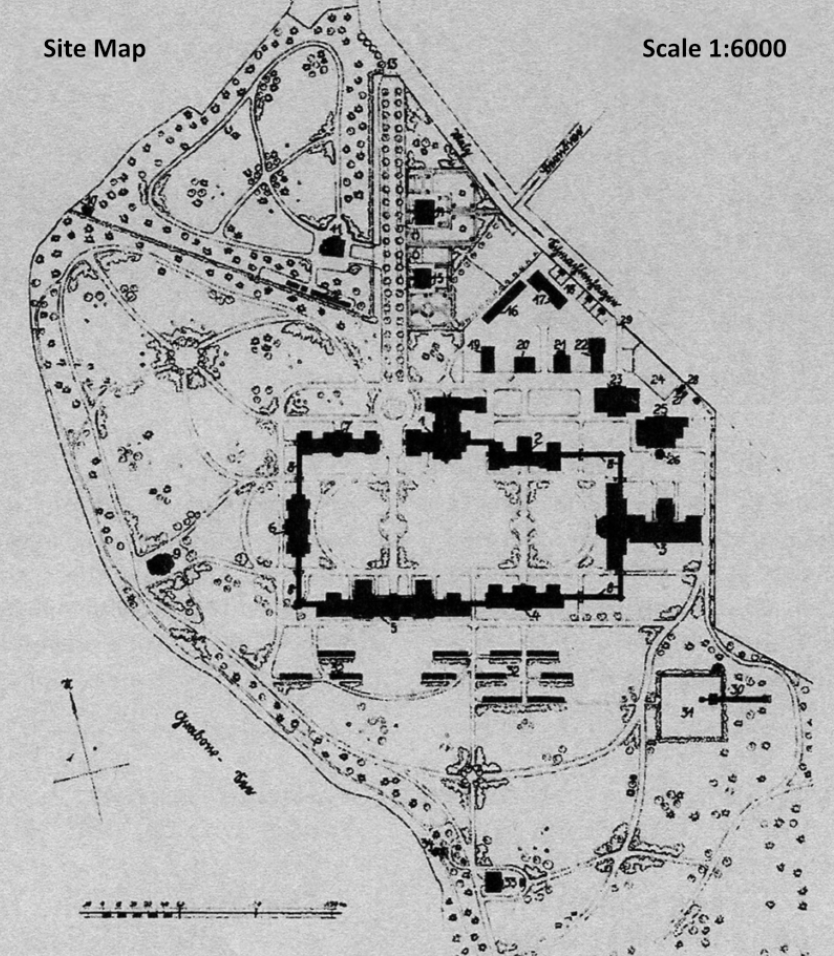
1. Administrative Building, 2. Robert Koch Building, 3. East Building, 4. Hans Boehm Building, 5. South Building, 6. Care Unit, 7. Admissions Ward, 8. Connecting corridors, 9. Chapel, 10. Ice cellar, 11. Director’s mansion, 12. Director’s stables, 13. North gate, 14. Doctors‘ residence, 15. Clerks‘ residence, 16. Coach house, 17. Horse stable, 18. Staff stables, 19. Potatoe cellar, 20. Garage, 21. Fire equipment shed, 22. Pigsty, 23. Wash house, 24. Coal yard, 25. Engine house, 26. Elevated reservoir chimney, 27. Centesimal scales, 28. Coal-loading gate, 29. Trade gate, 30. Bowling alley, 31. Air bath, 32. Recumbent resting pavilions, 33. Gardeners’ house, 34. Lake water pump room.
The sanatorium for lung patients near Oranienburg was erected step by step from 1896 to house 200 patients’ beds for men. Built by the Red Cross Association for Public Sanatoriums in an austere style characteristic of hospital buildings, the sanatorium was financed by donations and, in 1920, acquired by the Regional Insurance Office of Brandenburg. Its initial director was the chief medical consultant Dr Schultes. Since then the sanatorium has, without reducing the scale of its operations, been entirely rebuilt following architectural plans drawn up by, and built under the management of, the government’s master architect Arnold Beschoren of Berlin.
The task of the institute is to provide medical treatment for tubercular men from lower Germany while allowing them to continue residing in the hard climate of their former and future places of residence. The treatment is designed to cure not only mildly ill, but also seriously and incurably ill people who are confined to the institute on a continuous voluntary basis as so-called parole patients. To this end, also from an architectural point of view, it is necessary to provide the patients with sanguinity and homelike comforts while constantly adapting measures in line with the disposable, but often limited, funding, and without indulging insured patients who are accustomed to modest living conditions.
Buildings and interior fittings should, on the one hand, comply with the latest standards required for the treatment of tuberculosis. On the other hand, they should be suited for conditions required by other types of curative treatment in anticipation of the hoped-for end of the epidemic.
For this reason, everything is unostentatious and designed with the aim of facilitating the management of the sanatorium. The functional form of the groundplan and structure is clearly arranged, with colours and details combining into an art form which blends seamlessly into the scenery of the forest park around the languorous Grabowsee lake, and which stands aloof, having overcome the fear of the bacillus and evinced trust in the sun as the giver and sustainer of life while avoiding any artistic falsehood.
To this end, the colour scheme has been developed from the outset on the basis of Ostwald’s colour encoding system. The entire institute is made of building components and comprises interior fittings which are arranged in accordance with the character of their materials. The colour scheme consists of tones which are never dull, but invariably vivid, combined partly with achromatic shades such as white, grey or black, and partly with distinctly colourful shades to create a deliberate contrast. In order to establish coherency throughout the buildings, one colour shade is applied on each floor using a proportional range of the colour circle in each case; this colour shade is given special emphasis in public areas and provides a point of reference for the shades of colour applied similarly to other rooms on each floor of the building.
Although the building project is not yet complete, it is advanced enough for the institute to accommodate over 400 patients’ beds and 150 beds for staff.
Among people working on the construction, the architect Max Kobro oversaw the overall management of the project, while the architect Kochruebe was in charge of planning, and the master workman Kubowitz in charge of the site.

From the patients’ rooms, rooms for recumbent resting and day rooms situated on the southern façade of the South Building seen here on the right, one can look out across the extensive south park, which was designed in the fashion of traditional English gardens, to the Grabowsee lake with its surrounding forests. The enclosed corridors connecting buildings all around the courtyard enable patients to go on prolonged walks even when the weather is extremely cold.

When standing on the casino terrace one can look down across the spacious courtyard with its green lawns and clusters of trees, shrubs and bushes, and see the South Building on the left. The two deaerators protruding from the lawn like mushrooms indicate the route taken by the electronic underground railway, which carries meals and drinks prepared in the central kitchen facility in the Adminstrative Building to the South Building, where dumb waiters convey food to the ward kitchens on each floor, where in turn they are dished up and served in the adjacent dining rooms.

1. Nurses’ bathroom, 2. Caretakers’ room, 3. Patients’ lavatory, 4. Broom cupboard, 5. Dining room, 6. Ward kitchen, 7. Dumb waiter, 8. Balcony, 9. Day room, 10. Ward room, 11. Treatment room, 12. Patients’ bathroom, 13. Recumbent resting bag room, 14. Patients’ lavatories, 15. Equipment room, 16. Bed lift, 17. Nurses’ room, 18. Nurses’ bathroom, 19. Recumbent resting loggia, 20. Patient’s room for one bed, 21. Patients’ room for two beds, 22. Patients’ room for three beds, 23. Patients’ room for four beds, 24. Day room, 25. Recumbent resting veranda, 26. Staircase.

The Care Unit stands on the narrower western portion of the 1.5 hectare courtyard. It houses medical rooms used for examining and treating patients, as well as for research and instruction. The upper floor contains living quarters for guests, trainee doctors and some essentially required sanatorium staff. The ridge turret contains an electronic clock and weather vane which are illuminated by night and are visible from all sides.

1. Director’s office, 2. Director’s examination room, 3. Director’s waiting room, 4. Secretary’s office, 5. Lecture theatre, 6. Film archive, 7. Laryngeal operating room, 8. Laboratory (1), 9. Laboratory (2), 10. Undressing room, 11. X-ray diagnosis room, 12. Switch room, 13. Instrument room, 14. X-ray therapy room, 15. Doctors’ lavatory, 16. Nurses’ lavatory, 17. Patients’ lavatories, 18. Film developing room, 19. Film loading room, 20. Waiting room, 21. Artificial sunlamp room, 22. Dental treatment room, 23. Aseptic operating room, 24. Bandaging room, 25. Staircase, 26. Corridor, 27. Central hallway.
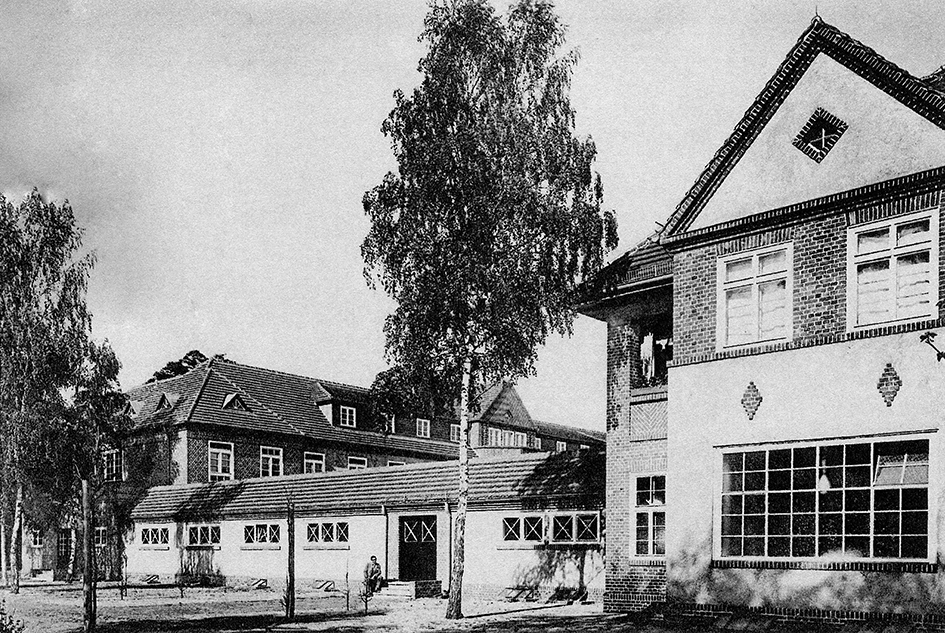
A group of buildings facing the Grabowsee lake, which show how the architects endeavoured to ensure that the single-purpose buildings are effortlessly in tune with the landscape.
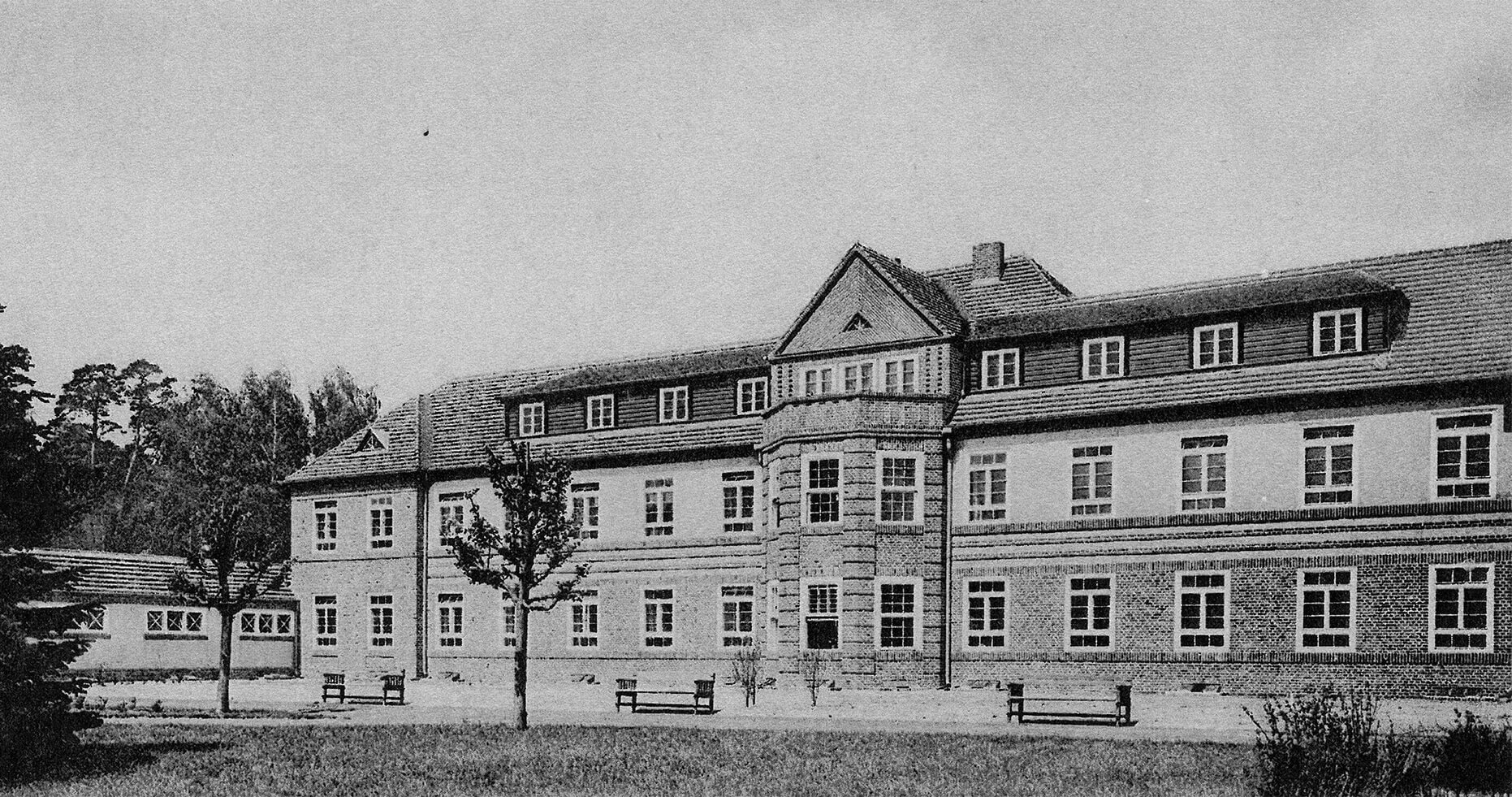
The Admissions Ward, built in 1928, is where patients are placed under observation before the start of their curative treatment. Since this building is reserved exclusively for admissions, the south facing rooms are not fitted with adjoining rooms for recumbent patients. The windows with additional lower panels have proved themselves in practice. They make it possible to air the rooms without having to shift plant pots, enable patients who are either sitting or standing to enjoy an unobscured view from the windows, and ensure that patients, as often is the case, do not lie for long periods near to open windows.

1. Recumbent resting bag room, 2. Caretakers’ room, 3. Laundry room, 4. Caretakers’ lavatory, 5. Treatment room, 6. Patients’ bathroom vestibule, 7. Patients’ bathroom, 8. Ward room, 9. Shoe polishing room, 10. Patients’ lavatories, 11. Patients’ lavatories vestibule, 12. Broom cupboard, 13. Doctors’ lavatory, 14. Nurses’ bathroom, 15. Nurses’ room, 16. Ward kitchen, 17. Cloakroom, 18. Patient’s room for four beds, 19. Patient’s room for two beds, 20. Day room, 21. Staircase, 22. Corridor, 23. Vestibule.
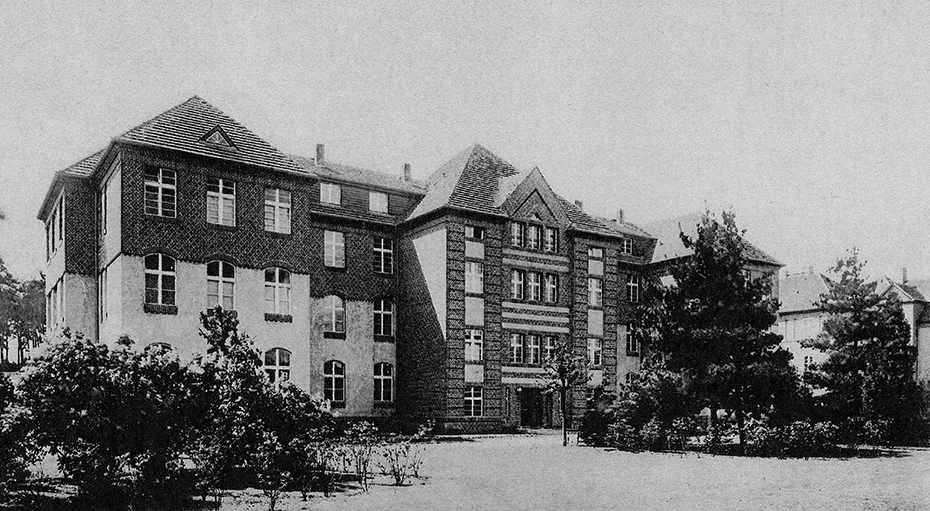
The Hans Boehm Building, a ward for 72 patients’ beds.
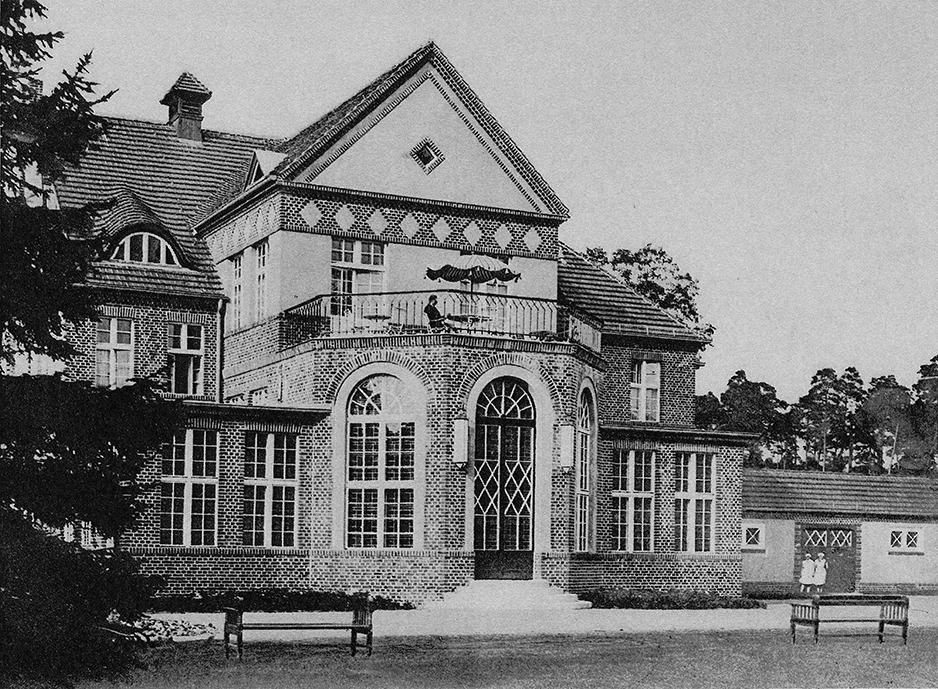
The Administrative Building houses the hall, which is accessible from the courtyard. This serves primarily as the dining hall for almost 300 patients who get their meals here centrally, while other patients’ buildings feature their own decentral dining rooms. The hall also serves as a ceremonial hall for prospective gatherings of up to 550 people comprised of patients and sanatorium staff. The rooms above the hall, which are conveniently situated close to the neighbouring kitchens, are used as a casino for senior and intermediary staff.
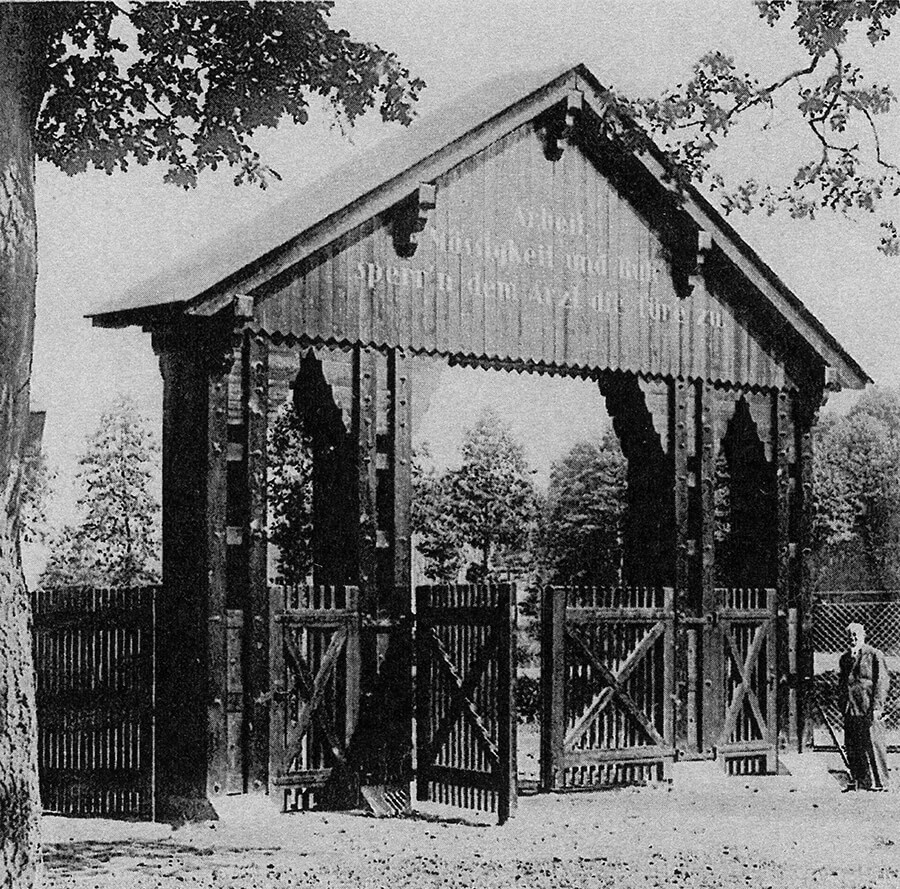
The inside of the North Gate of the sanatorium estate is inscribed with a motto which was awarded the best prize in a medical contest, and which outlines the natural modern notion of hygiene.

The signposts both within and beyond the premises have proved to be expedient because they are void of unnecessary embellishment and use vivid colour combinations to attract the attention of passing motor vehicles.
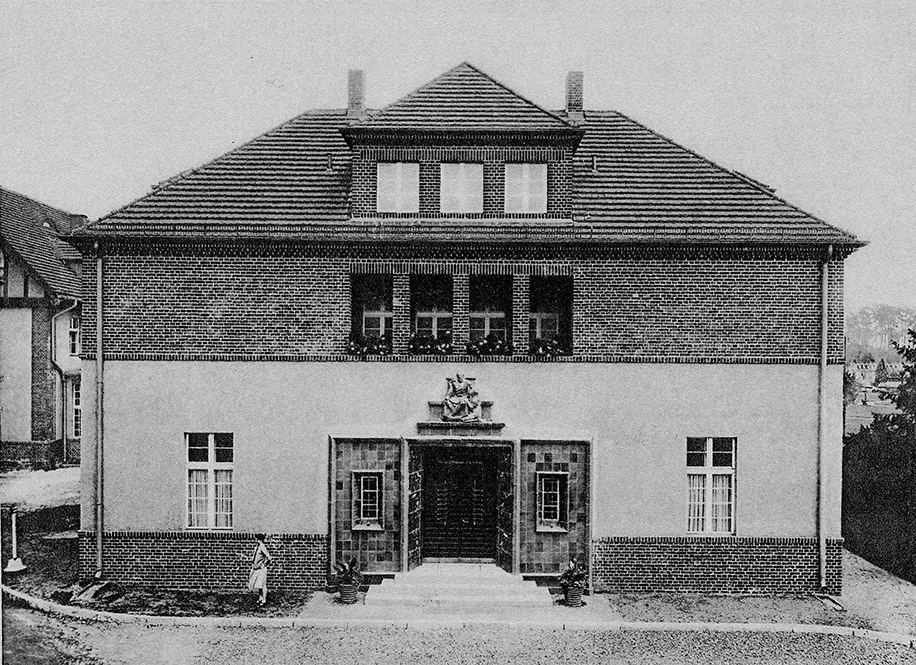
The Administrative Building, via its main entrance, is constructed to look as little like a hospital as possible in order to ensure that patients might adopt a cheerful mood as they take their first steps into the sanatorium.
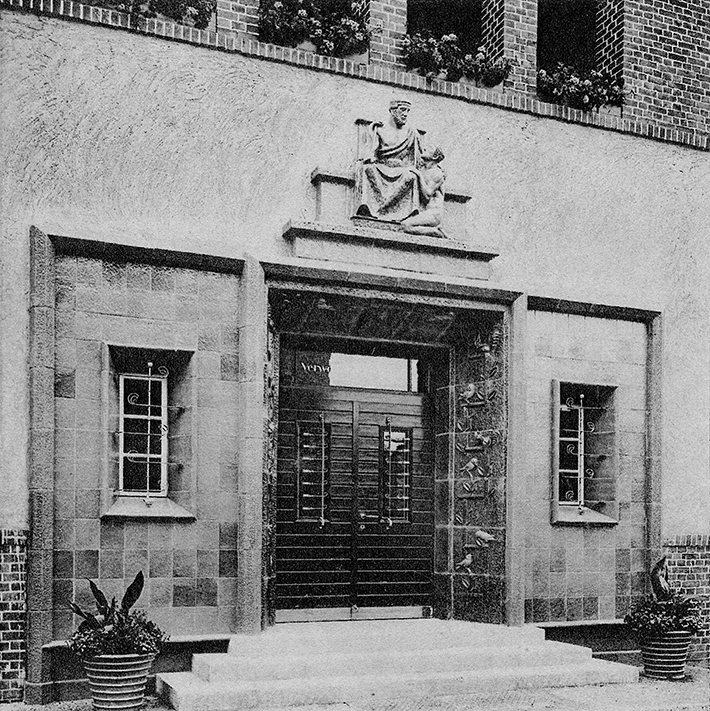
The main entrance of the Administrative Building is striking yet soberly accentuated with ceramic details whose forms and colours are conducive to cheerfulness.
Sculptor Lehmann-Borges, Gildenhall, and blacksmith Siegfried Pruetz, Gildenhall.
The panels inlaid in the doors of the main entrance of the Admissions Ward contain leaf gilded wrought iron latticework which features the motto characteristic of contemporary curative treatments, ‘WATER, AIR, SUNSHINE, THREE GOOD REMEDIES’.
Blacksmith Professor Pruetz, Gildenhall.
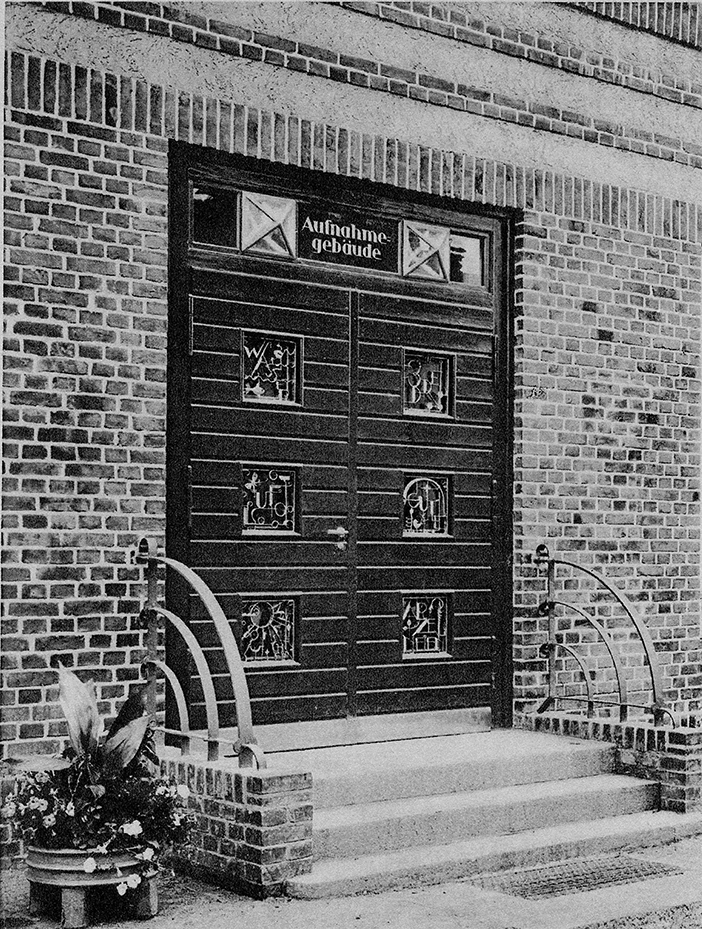

Leaf gilded wrought iron latticework, which arrestingly illustrates the concept of water.
Blacksmith Professor Pruetz, Gildenhall.
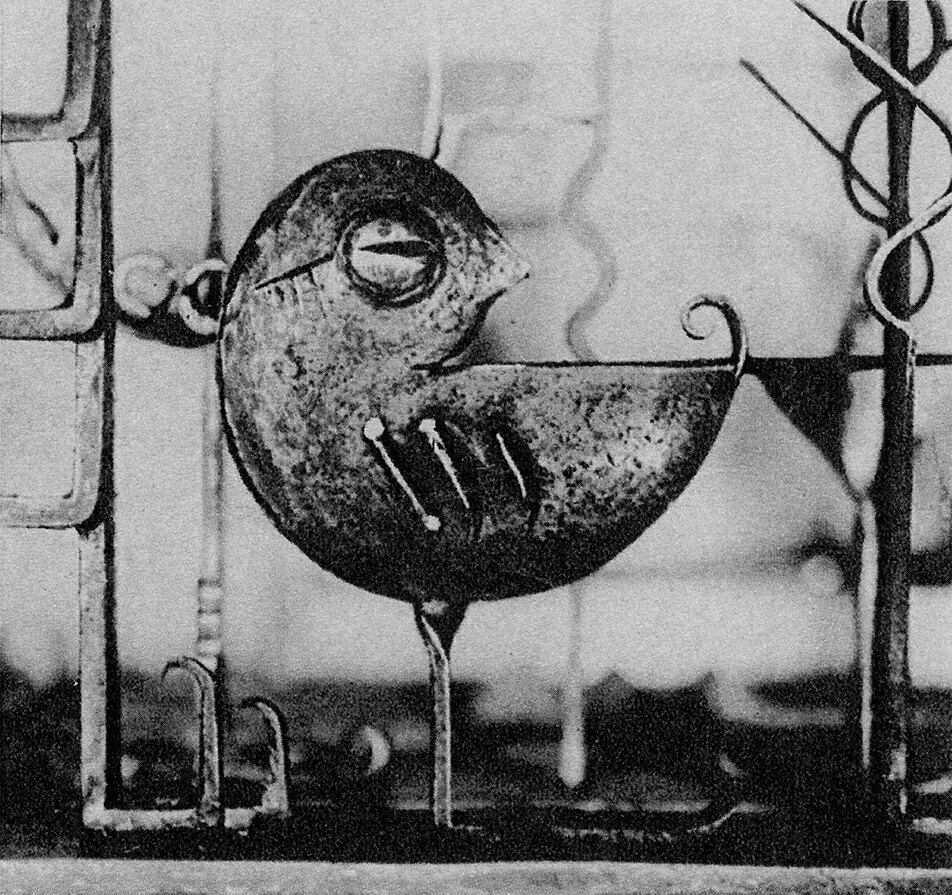
Detail of the latticework ‘good’.
Blacksmith Professor Pruetz, Gildenhall.

On the ground floor of the western facade of the Care Unit, facing outwards away from the patients‘ area, there are irradiation rooms and operating theatres and, in the cellar, a mortuary and coffin lift.

The coffin lift situated on the western facade of the Care Unit serves to raise coffins swiftly and unobserved from the obduction room while keeping them horizontal before they are laid out in the neighbouring chapel.
Construction: Paul Marcus, Berlin.

The electronic underground railway runs between the Administrative Building and the South Building along a tunnel without accompanying personnel, and stops automatically in front of the dumb waiters on both sides of the tracks.

The recumbent resting pavillions made of logs and with reed roofs have proved to provide more effective shelter from heat and coldness than the widely recommended solid glass constructions. They also blend well into the landscape on account of their natural colour combinations.

The loggias for recumbent patients contain two levels so that the second row of deckchairs is also exposed to air and offers a clear view through the window.

Connecting pavilion at the point where two connecting corridors meet, with bench seats for patients warmed from below by an air heating system.
Sculptor Lehmann-Borges, Gildenhall.
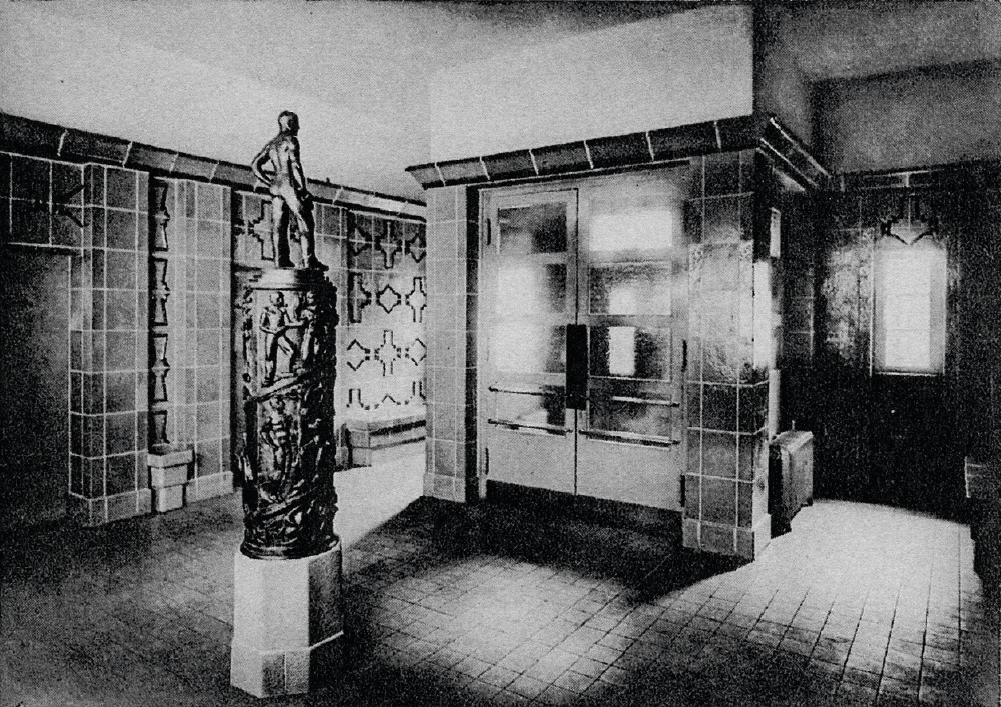
On arrival the patients enter the Administrative Building via the vestibule and see a bronze ornamented column which depicts cheerful scenes demonstrating how they may regain health and their ability to work by adhering to medical instructions in the course of the series of phases of the healing process.
Sculptor Otto Maerker, Berlin.
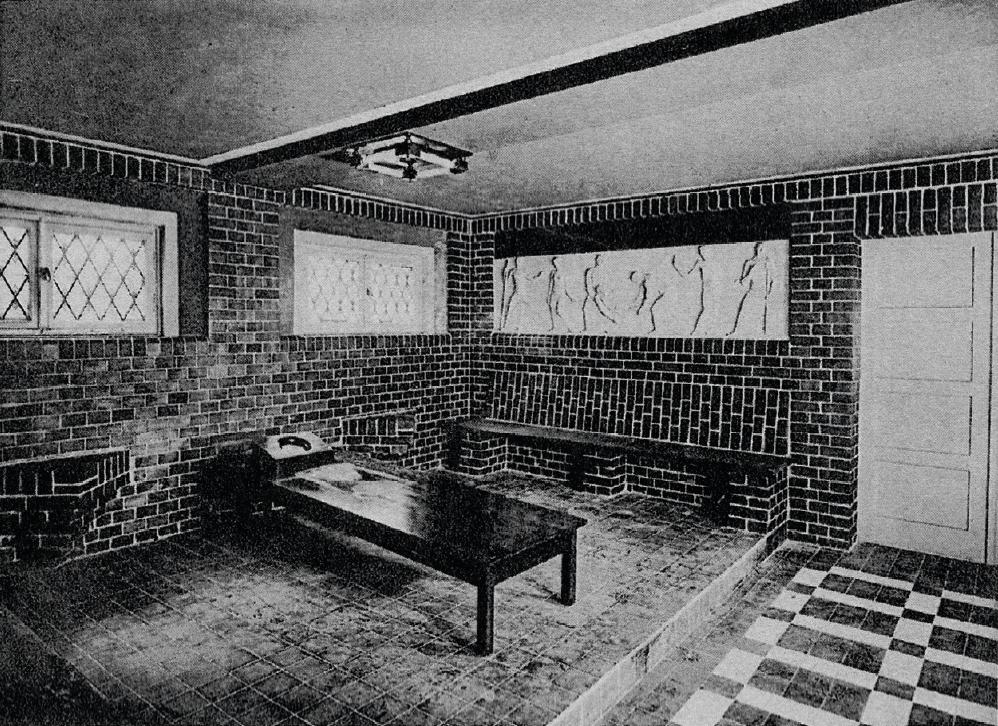
The mortuary is used to lay out deceased patients to whom next of kin wish to bid farewell. Two wall friezes evoke the themes of life and death.
Sculptor Otto Maerker, Berlin.
The old staircase in the Hans Boehm Building acquired considerable contours following the addition of colour combinations. Classic grey oil-coloured walls enhanced with randomly arranged zinc markings, alongside slate grey ceilings with aluminium bronze overlay, contrast starkly with the colourful doors, which are painted with the shade of colour allotted to each respective floor.
Painter Erich Wolf, Berlin.


One of the winding staircases in the Care Unit with central rod lighting, leading into the enclosed connection corridor.
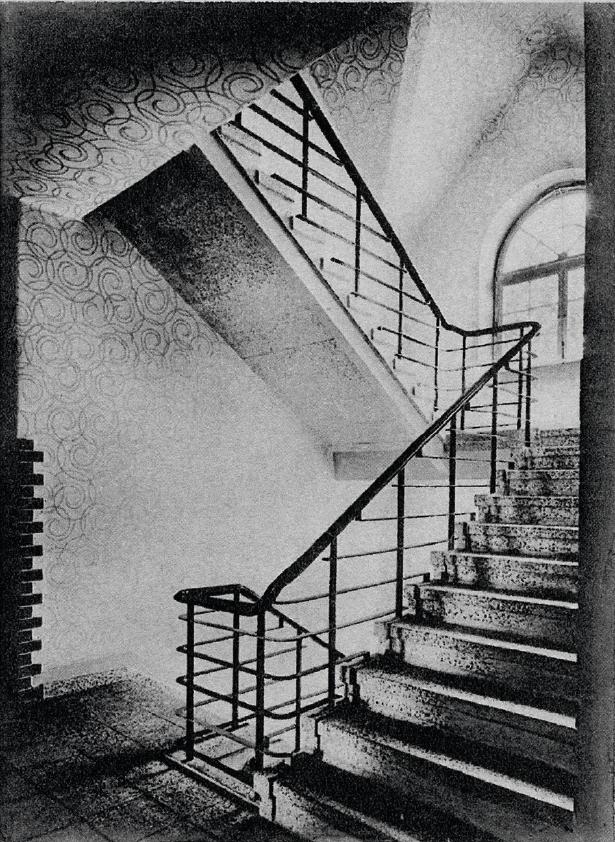
The staircases made of cast stone enhanced with hardening additives are equipped with simple, easily cleaned wrought iron banisters.
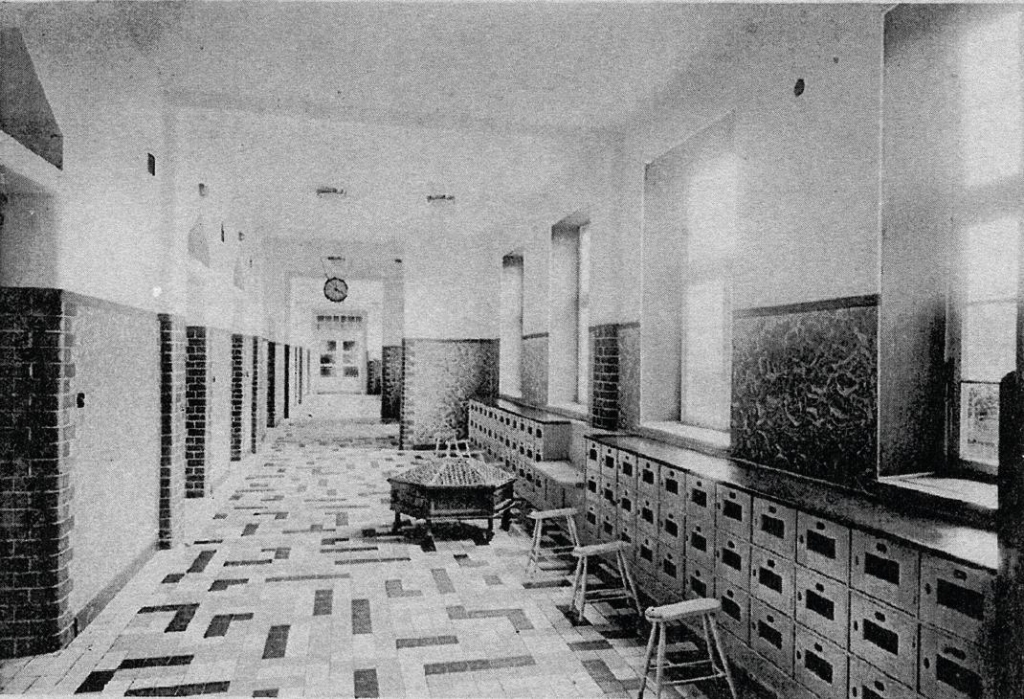
Shoe polishing room with randomly arranged floor tiling patterns, which makes dirt marks left by passers-by less visible, with shoe cupboards and a circular shoe cleaning cabinet.

On the upper floor of the South Building the north facing day room is separated from the south facing day room by flap doors in such a way that, when opened, together they can be used for lectures and performances. For this purpose the central part of the day room can be screened off from both lateral parts of the room with curtains and also, for cinema projections, blackened out with dark-room equipment.
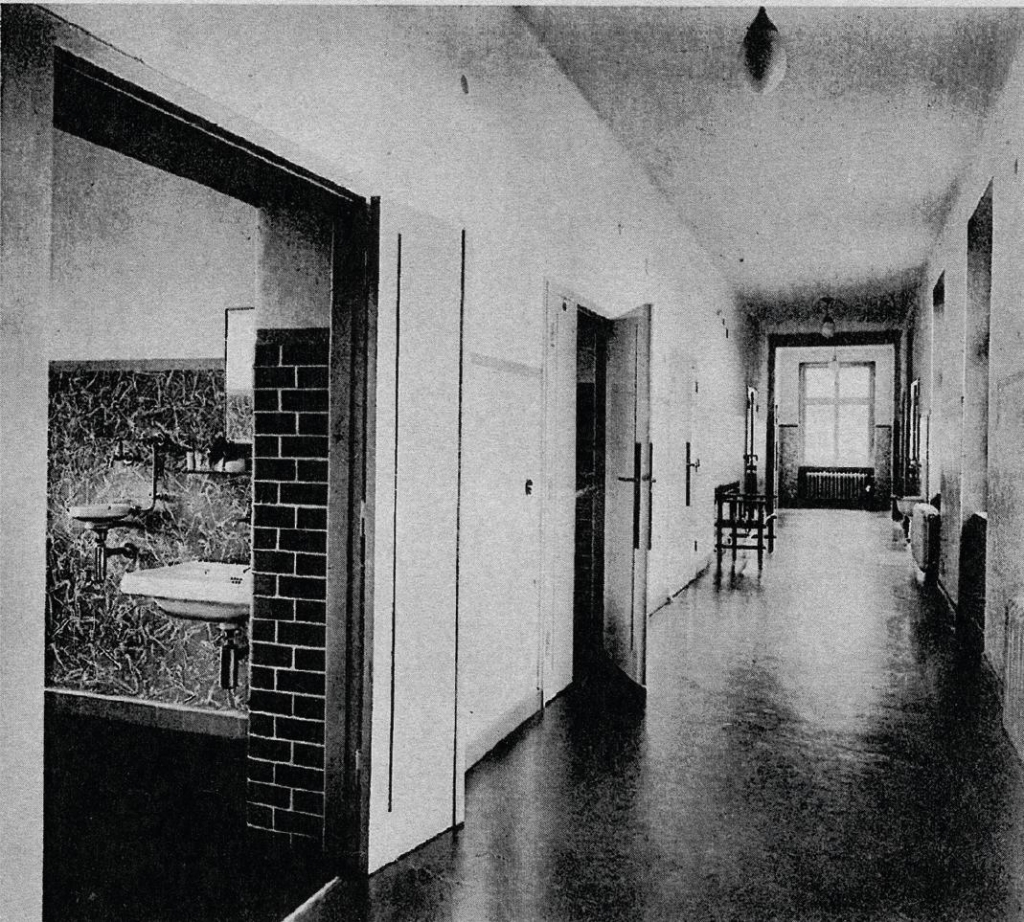
The doors leading from patients‘ rooms to the broad corridors are two-winged and unequal in width. The broad wing of the door is used to access the room, with an additional narrow door wing through which beds are wheeled.
The casino rooms for senior and intermediary staff are situated above the high centre aisle of the hall and lead into the casino vestibule.
Painter Erich Wolf, Berlin.

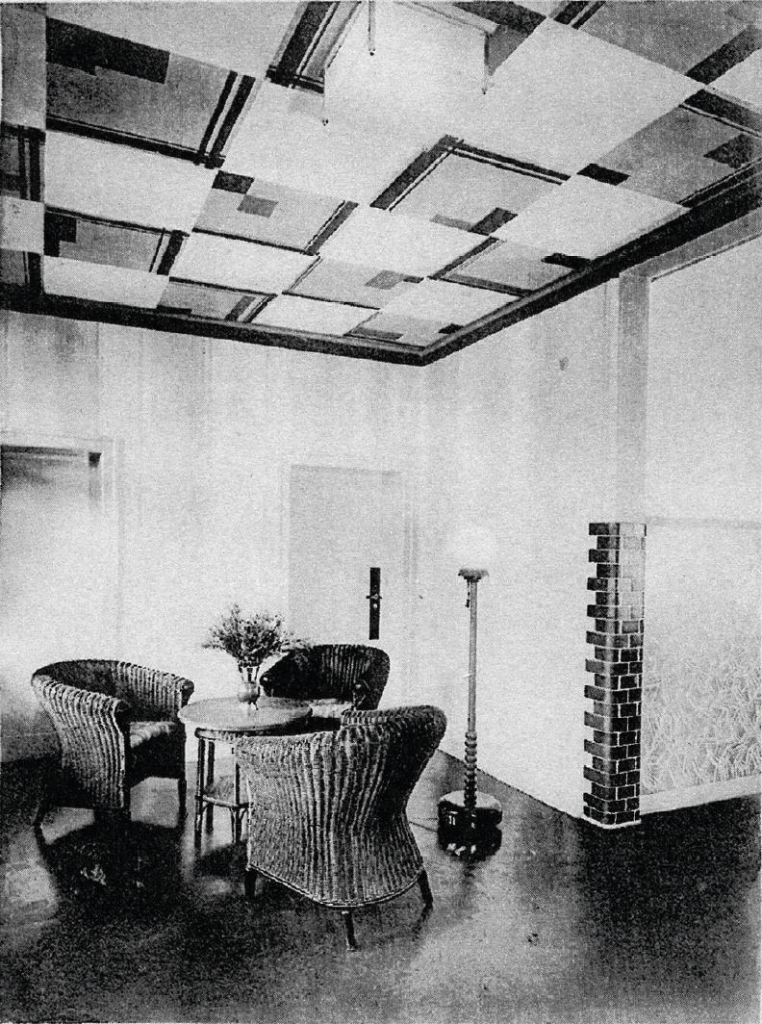
Day room with connecting corridor. This room, which is surrounded by staff rooms, serves by day as a common room. Protuberant iron oxide bricks protect corners of all walls from damage.
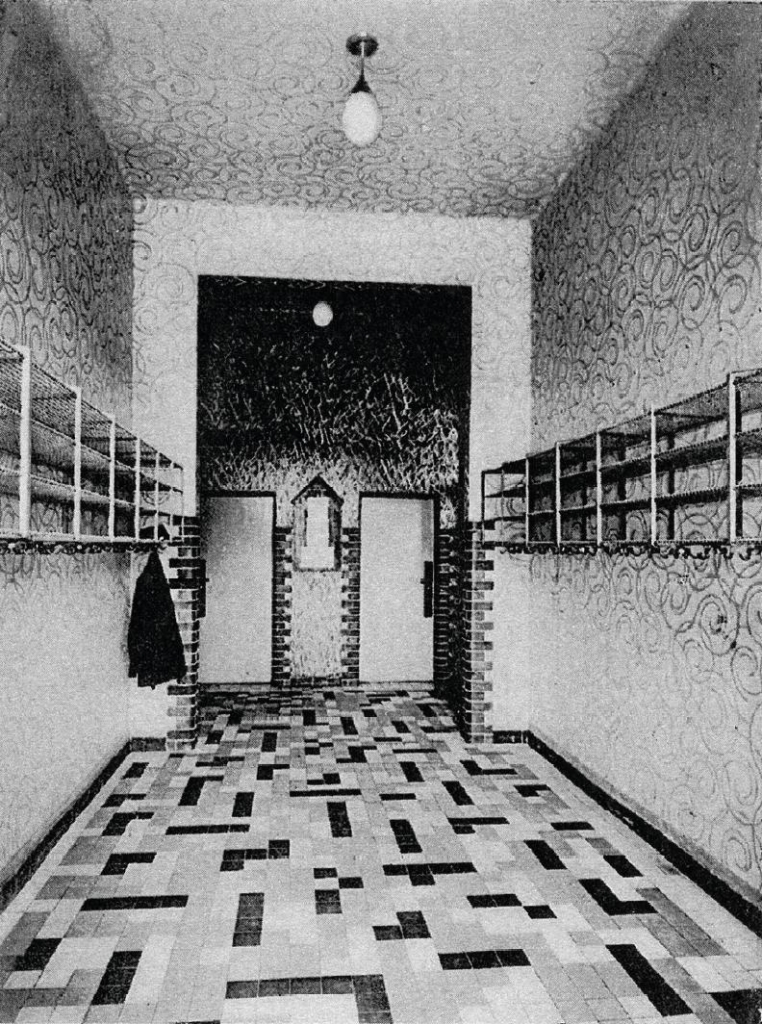
The hall in the Administrative Building can be accessed from the courtyard via two symmetrically located cloakrooms on each side, which contain space-saving cloakroom shelves and hooks to protect clothes.
Blacksmith Ferdinand Schwarze, Berlin.
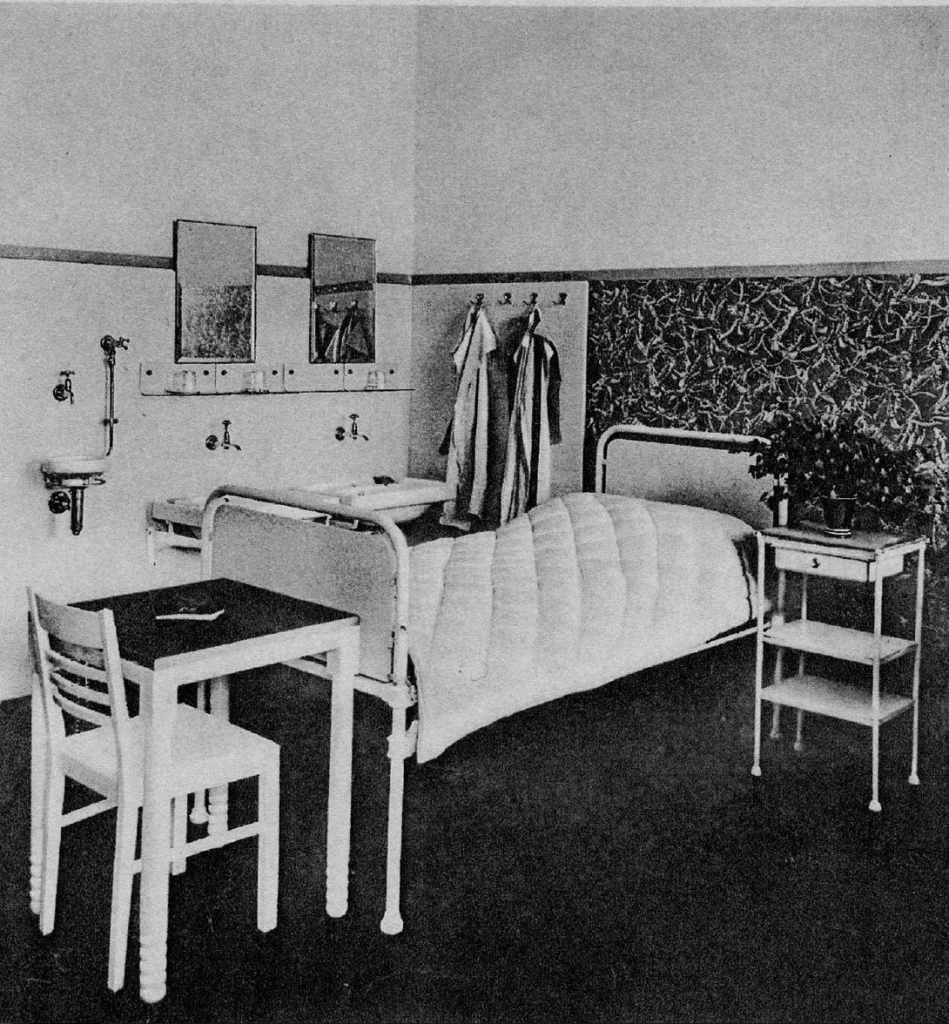
All one- to four-bed patients‘ rooms have a sanitary but also, with their vivid lively colour combinations, cheerful appearance.

The central control room is constructed in such a way that radiology staff are unavoidably protected against scattered rays even in cases of carelessness.
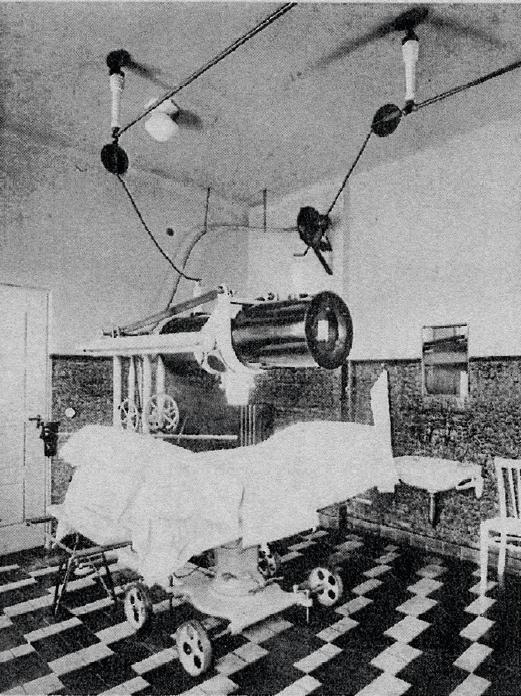
The x-ray facility, which runs on a 180,000 volt power source, comprises the radiology therapy room visible in this image.
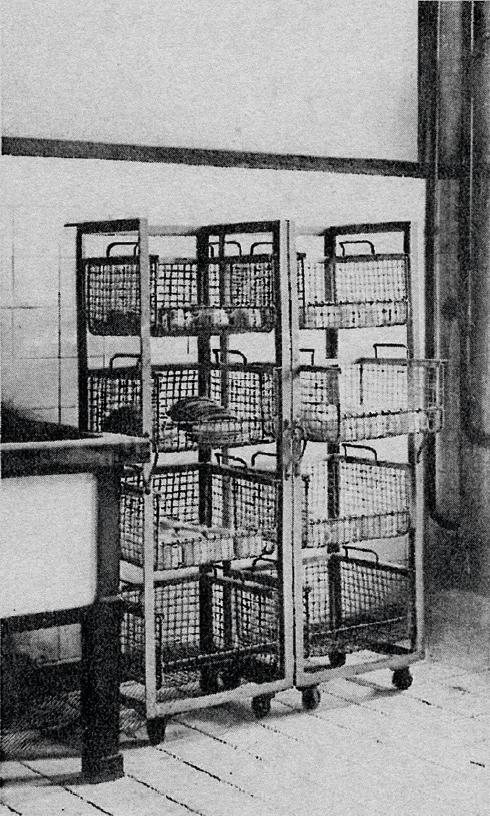
In the ward kitchens next to the dining rooms there are practical washing-up towers where dirty dishes can be placed after use.

Lecture theatre, which is also used as a conference room and library.
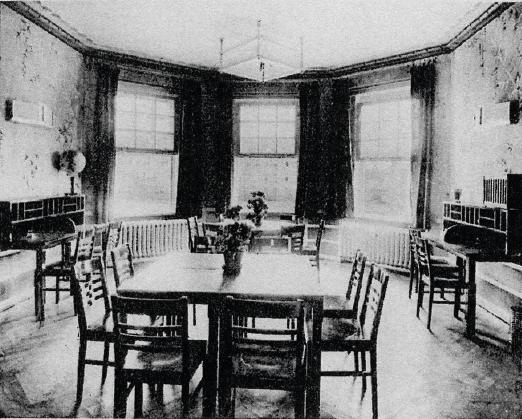
The day rooms are equipped with all kinds of things which can stimulate and occupy the patients, with furniture designed for reading, writing and playing games, with a celestial globe, an earth globe, a barometer, books and loudspeakers.

The day rooms and all other patients’ and staff rooms are equipped with sets of tables of identical height and width of the Beschoren type, and patented under the name of ‘Kontabolo’ DRP 474152. They can be combined for any number of people to create almost any imaginable form, and therefore constitute a unique type of composite furniture.

Casino for senior and intermediary staff. Furnished with standard sets of tables of the Beschoren type.

Dining room with seating for 48 patients situated in a shadow-free area which is illuminated by daylight in the daytime and by light lattices in the evening.
Workshop of the wood turner E. Schrammen, Gildenhall.
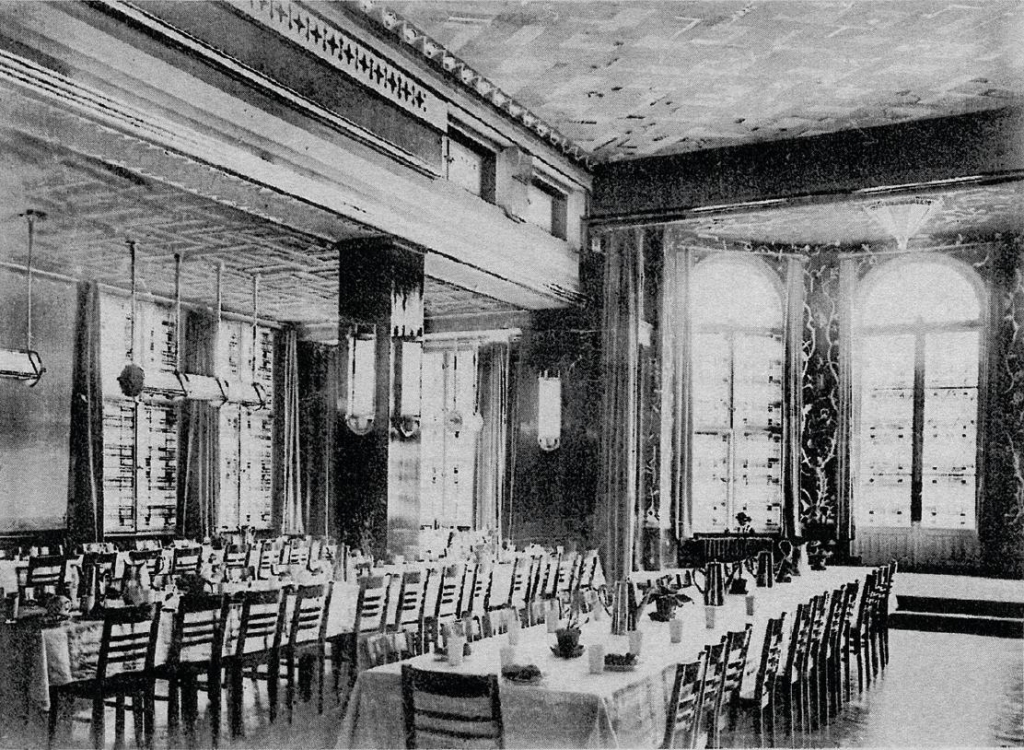
Hall for approximately 300 patients, with a podium for lectures, demonstrations and performances.

